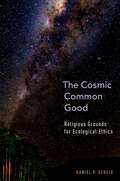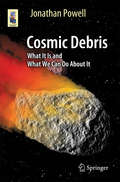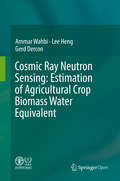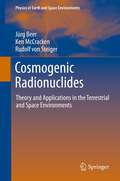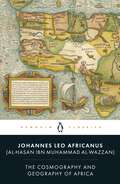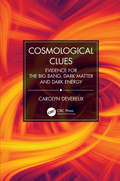- Table View
- List View
The Cosmic Common Good: Religious Grounds for Ecological Ethics
by Daniel P. ScheidAs ecological degradation continues to threaten permanent and dramatic changes for life on our planet, the question of how we can protect our imperiled Earth has become more pressing than ever before. In this book, Daniel Scheid draws on Catholic social thought to construct what he calls the "cosmic common good," a new norm for interreligious ecological ethics. This ethical vision sees humans as an intimate part of the greater whole of the cosmos, emphasizes the simultaneous instrumental and intrinsic value of nature, and affirms the integral connection between religious practice and the pursuit of the common good. When ecologically reoriented, Catholic social thought can point the way toward several principles of the cosmic common good, such as the virtue of Earth solidarity and the promotion of Earth rights. These are rooted in the classical doctrines of creation in Augustine and Thomas Aquinas, and in Thomas Berry's interpretation of the evolutionary cosmic story. The cosmic common good can also be found in Hindu, Buddhist, and American Indian religious traditions. By placing a Catholic cosmic common good in dialogue with Hindu dharmic ecology, Buddhist interdependence, and American Indian balance with all our relations, Scheid constructs a theologically authentic moral framework that re-envisions humanity's role in the universe.
The Cosmic Common Good: Religious Grounds for Ecological Ethics
by Daniel P. ScheidAs ecological degradation continues to threaten permanent and dramatic changes for life on our planet, the question of how we can protect our imperiled Earth has become more pressing than ever before. In this book, Daniel Scheid draws on Catholic social thought to construct what he calls the "cosmic common good," a new norm for interreligious ecological ethics. This ethical vision sees humans as an intimate part of the greater whole of the cosmos, emphasizes the simultaneous instrumental and intrinsic value of nature, and affirms the integral connection between religious practice and the pursuit of the common good. When ecologically reoriented, Catholic social thought can point the way toward several principles of the cosmic common good, such as the virtue of Earth solidarity and the promotion of Earth rights. These are rooted in the classical doctrines of creation in Augustine and Thomas Aquinas, and in Thomas Berry's interpretation of the evolutionary cosmic story. The cosmic common good can also be found in Hindu, Buddhist, and American Indian religious traditions. By placing a Catholic cosmic common good in dialogue with Hindu dharmic ecology, Buddhist interdependence, and American Indian balance with all our relations, Scheid constructs a theologically authentic moral framework that re-envisions humanity's role in the universe.
Cosmic Debris: What It Is and What We Can Do About It (Astronomers' Universe)
by Jonathan PowellThis book examines the mysterious and the well-studied debris in Earth’s crowded neighborhood. From orbiting comets to the workings of the Asteroid Belt, and from meteor showers to our home-grown network of orbiting satellites, the full diversity of space objects and the debris they create is explored. Powell also discusses some of the current research techniques used to find potentially harmful rogue elements, with an emphasis on keeping watch for any objects that may intersect Earth’s orbit. Such bodies also impact other worlds, and much has been learned from observing these encounters.The information in this book is intended to foster thought about the universe in which we live, but without overloading its readers with numbers and lecture-room analysis. Like a good thriller, it allows its readers to pace themselves with the story and, by the end, encourages them to draw their own conclusions.
Cosmic Electrodynamics: Electrodynamics and Magnetic Hydrodynamics of Cosmic Plasmas (Astrophysics and Space Science Library #388)
by Gregory D. Fleishman Igor N. ToptyginThis book presents the fundamental concepts of the theory, illustrated by numerous examples of astrophysical applications. Classical concepts are combined with new developments and the authors demarcate what is well established and what is still under debate. To book illustrates how apparently complicated phenomena can be addressed and understood using well-known physical principles and equations within appropriate approximations and simplifications. For this purpose, a number of astrophysical examples are considered in greater detail than what is normally presented in a regular textbook. In particular, a number of nonlinear self-consistent models are considered, which is motivated by the latest observational data and modern theory.
The Cosmic Keyhole: How Astronomy Is Unlocking the Secrets of the Universe (Astronomers' Universe)
by Will GaterIn the last thirty years humans have probed the Universe, explored the Solar System and visited with spacecraft some of the most incredible places humans have ever laid eyes upon. We have expanded our knowledge slowly and surely, but still now only see a glimpse of the bigger picture. The Cosmic Keyhole explores the big discoveries of recent years and asks what’s next? How prolific is life in the Universe? How far back to the Big Bang can we probe? And what hidden treasures still await us in the hidden corners of our Solar System?
Cosmic Plasma Physics (Astrophysics and Space Science Library #251)
by B.V. SomovThis unusual book considers physical principles, starting from the most general ones, and simplifies assumptions, helping students answer two key questions: what approximation is the simplest, but still sufficient for the description of a phenomenon in cosmic plasmas, and how to build an adequate model.
Cosmic Radiations: From Astronomy to Particle Physics (NATO Science Series II: Mathematics, Physics and Chemistry #42)
by Giorgio Giacomelli Maurizio Spurio Jamal Eddine DerkaouiNon-accelerator particle physicists, especially those studying neutrino oscillation experiments, will read with profit the in-depth discussions of new results and their interpretations. new guidelines are also set out for new developments in this and related fields. Discussions are presented of neutrino oscillations, neutrino astronomy, high energy cosmic rays, gravitational waves, magnetic monopoles and dark matter. The future large-scale research projects discussed include the experiments on long baseline neutrino beams from CERN to Gran Sasso and Fermilab to the Soudan mine; large underwater and under-ice experiments; the highest energy cosmic rays; gravitational waves; and the search for new particles and new phenomena.
Cosmic Ray Diffusion in the Galaxy and Diffuse Gamma Emission (Springer Theses)
by Daniele GaggeroThe original work presented in this thesis constitutes an important contribution to modern Cosmic Ray (CR) physics, and comes during one of the most exciting periods of this field. The first part introduces a new numerical code (DRAGON) to model the CR propagation in our Galaxy. The code is then used to perform a combined analysis of CR data, making it possible to determine their propagation properties with unprecedented accuracy. The second part is dedicated to a theoretical interpretation of the recent crucial experimental results on cosmic electron and positron spectra (PAMELA, Fermi-LAT experiments). Using the tools developed in the first part of the thesis, the author convincingly argues for the existence of a new spectral component, which could arise either from local astrophysical sources, such as pulsars, or from Dark Matter annihilation or decay. This thesis is a highly advanced work; the methods, analysis and results are clearly and carefully presented. This work is set to become an important reference document for any future work in this area.
Cosmic Ray Neutron Sensing: Estimation of Agricultural Crop Biomass Water Equivalent
by Ammar Wahbi Lee Heng Gerd DerconThis open access book provides methods for the estimation of Biomass Water Equivalent (BEW), an essential step for improving the accuracy of area-wide soil moisture by cosmic-ray neutron sensors (CRNS). Three techniques are explained in detail: (i) traditional in-situ destructive sampling, (ii) satellite based remote sensing of plant surfaces, and (iii) biomass estimation via the use of the CRNS itself. The advantages and disadvantages of each method are discussed along with step by step instructions on proper procedures and implementation.
Cosmic Rays: Multimessenger Astrophysics and Revolutionary Astronomy (Astronomers' Universe)
by Alessandro De AngelisIn recent years, cosmic rays have become the protagonists of a new scientific revolution. We are able today to film the Universe with telescopes of completely novel conception, recording information from many different messengers and accessing previously unknown cosmic regions.Written by a recognized authority in physics, this book takes readers on a captivating journey through the world of cosmic rays, their role in the revolutionary field of multi-messenger astronomy, their production from powerful accelerators close to the surfaces of black holes and compact objects, reaching the highest levels of energy observed in nature, and the implications this has for our understanding of the Universe. Through the stories of pioneering scientists, explorations of cutting-edge technologies, and simple explanations related to particle physics, quantum mechanics, and astrophysics, the book provides an illuminating state-of-the-art introduction to the current state of high-energy astrophysics. The book was written in straightforward yet rigorous language, so as to be accessible to the greater public. For those curious about the cosmos and cosmic gamma rays, nuclei, neutrinos, and gravitational waves, from casual observers to professional astronomers and physicists, the book is a must-read, offering a thrilling adventure into the future of astronomy and particle physics.
Cosmic Rays in Magnetospheres of the Earth and other Planets (Astrophysics and Space Science Library #358)
by Lev DormanThe problem of cosmic ray (CR) geomagnetic effects came to the fore at the beg- ning of the 1930s after the famous expeditions by J. Clay onboard ship (Slamat) between the Netherlands and Java using an ionization chamber. Many CR la- tude expeditions were organized by the famous scientists and Nobel Laureates R. Millikan and A. Compton. From the obtained latitude curves it follows that CRs cannot be gamma rays (as many scientists thought at that time), but must be charged particles. From measurements of azimuthally geomagnetic effect at that time it also followed that these charged particles must be mostly positive (see Chapter 1, and for more details on the history of the problem see monographs of Irina Dorman, M1981, M1989). The ?rst explanations of obtained results were based on the simple dipole - proximation of the geomagnetic ?eld and the theory of energetic charged particles moving in dipole magnetic ?elds, developed in 1907 by C. Stormer ¨ to explain the aurora phenomenon. Let us note that it was made about 5 years before V. Hess discovered CRs, and received the Nobel Prize in 1936 together with K. Anderson (for the discovery of CR and positrons in CR).
Cosmic Rays in the Earth’s Atmosphere and Underground (Astrophysics and Space Science Library #303)
by Lev DormanThe present monograph as well as the next one (Dorman, M2005) is a result of more than 50 years working in cosmic ray (CR) research. After graduation in December 1950 Moscow Lomonosov State University (Nuclear and Elementary Particle Physics Division, the Team of Theoretical Physics), my supervisor Professor D. I. Blokhintsev planned for me, as a winner of a Red Diploma, to continue my education as an aspirant (a graduate student) to prepare for Ph. D. in his very secret Object in the framework of what was in those time called the Atomic Problem. To my regret the KGB withheld permission, and I, together with other Jewish students who had graduated Nuclear Divisions of Moscow and Leningrad Universities and Institutes, were faced with a real prospect of being without any work. It was our good fortune that at that time there was being brought into being the new Cosmic Ray Project (what at that time was also very secret, but not as secret as the Atomic Problem), and after some time we were directed to work on this Project. It was organized and headed by Prof. S. N. Vernov (President of All-Union Section of Cosmic Rays) and Prof. N. V. Pushkov (Director of IZMIRAN); Prof. E. L. Feinberg headed the theoretical part of the Project.
Cosmic Update: Dark Puzzles. Arrow of Time. Future History (Multiversal Journeys)
by Fred Adams Thomas Buchert Laura Mersini-Houghton"...The Multiversal book series is equally unique, providing book-length extensions of the lectures with enough additional depth for those who truly want to explore these fields, while also providing the kind of clarity that is appropriate for interested lay people to grasp the general principles involved." - Lawrence M. KraussCosmic Update Covers:A novel approach to uncover the dark faces of the Standard Model of cosmology.The possibility that Dark Energy and Dark Matter are manifestations of the inhomogeneous geometry of our Universe.On the history of cosmological model building and the general architecture of cosmological modes.Illustrations on the Large Scale Structure of the Universe.A new perspective on the classical static Einstein Cosmos.Global properties of World Models including their Topology.The Arrow of Time in a Universe with a Positive Cosmological Constant.Exploring the consequences of a fundamental Cosmological Constant for our Universe. Exploring why the current observed acceleration of the Universe may not be its final destiny.Demonstrating that nature forbids the existence of a pure Cosmological Constant.Our current understanding of the long term (in time scales that greatly exceed the current age of the Universe) future of the Universe.The long term fate and eventual destruction of the astrophysical objects that populate the universe -- including clusters, galaxies, stars, planets, and black holes. The material is presented in a layperson-friendly language followed by addition technical sections that explain the basic equations and principles. This feature is very attractive to readers who want to learn more about the theories involved beyond the basic description. "Multiversal Journeys™ is a trademark of Farzad Nekoogar and Multiversal Journeys, a 501 (c) (3) nonprofit organization."
The Cosmic Zoo: Complex Life on Many Worlds
by Dirk Schulze-Makuch William BainsAre humans a galactic oddity, or will complex life with human abilities develop on planets with environments that remain habitable for long enough? In a clear, jargon-free style, two leading researchers in the burgeoning field of astrobiology critically examine the major evolutionary steps that led us from the distant origins of life to the technologically advanced species we are today. Are the key events that took life from simple cells to astronauts unique occurrences that would be unlikely to occur on other planets? By focusing on what life does - it's functional abilities - rather than specific biochemistry or anatomy, the authors provide plausible answers to this question. Systematically exploring the various pathways that led to the complex biosphere we experience on planet Earth, they show that most of the steps along that path are likely to occur on any world hosting life, with only two exceptions: One is the origin of life itself – if this is a highly improbable event, then we live in a rather “empty universe”. However, if this isn’t the case, we inevitably live in a universe containing a myriad of planets hosting complex as well as microbial life - a “cosmic zoo”. The other unknown is the rise of technologically advanced beings, as exemplified on Earth by humans. Only one technological species has emerged in the roughly 4 billion years life has existed on Earth, and we don’t know of any other technological species elsewhere. If technological intelligence is a rare, almost unique feature of Earth's history, then there can be no visitors to the cosmic zoo other than ourselves. Schulze-Makuch and Bains take the reader through the history of life on Earth, laying out a consistent and straightforward framework for understanding why we should think that advanced, complex life exists on planets other than Earth. They provide a unique perspective on the question that puzzled the human species for centuries: are we alone?
Cosmochemistry and the Origin of Life: Proceedings of the NATO Advanced Study Institute held at Maratea, Italy, June 1–12, 1981 (Nato Science Series C: #101)
by Cyril PonnamperumaFor the first time in human history, developments in many branches of science provide us with an opportunity of formula ting a comprehensive picture of the universe from its beginning to the present time. It is an awesome reflection that the carbon in our bodies is the very carbon which was generated during the birth of a star. There is a perceptible continuum through the billions of years which can be revealed by the study of chemistry. Studies in nucleosynthesis have related the origin of the elements to the life history of the stars. The chemical elements we find on earth, HYdrogen, Carbon, Oxygen, and Nitrogen, were created in astronomical processes that took place in the past, and these elements are not spread throughout space in the form of stars and galaxies. Radioastronomers have discovered a vast array of organic molecules in the interstellar medium which have a bearing on prebiological chemical processes. Many of the molecules found so far contain the four elements, C, N, 0, H. Except for the chem ically unreactive He, these four elements are the most abundant in the galaxy. The origin of polyatomic interstellar molecules is an unresolved problem. While we can explain the formation of some diatomic molecules as due to two atom collisions, it is much more difficult to form polyatomic molecules by collisions between diatomic molecules and atoms. There may be other produc tion mechanisms at work such as reactions taking place on the surface of interstellar dust grains.
Cosmogenic Radionuclides: Theory and Applications in the Terrestrial and Space Environments (Physics of Earth and Space Environments)
by Jürg Beer Ken McCracken Rudolf SteigerCosmogenic radionuclides are radioactive isotopes which are produced by natural processes and distributed within the Earth system. With a holistic view of the environment the authors show in this book how cosmogenic radionuclides can be used to trace and to reconstruct the history of a large variety of processes. They discuss the way in which cosmogenic radionuclides can assist in the quantification of complex processes in the present-day environment. The book aims to demonstrate to the reader the strength of analytic tools based on cosmogenic radionuclides, their contribution to almost any field of modern science, and how these tools may assist in the solution of many present and future problems that we face here on Earth. The book provides a comprehensive discussion of the basic principles behind the applications of cosmogenic (and other) radionuclides as environmental tracers and dating tools. The second section of the book discusses in some detail the production of radionuclides by cosmic radiation, their transport and distribution in the atmosphere and the hydrosphere, their storage in natural archives, and how they are measured. The third section of the book presents a number of examples selected to illustrate typical tracer and dating applications in a number of different spheres (atmosphere, hydrosphere, geosphere, biosphere, solar physics and astronomy). At the same time the authors have outlined the limitations of the use of cosmogenic radionuclides. Written on a level understandable by graduate students without specialist skills in physics or mathematics, the book addresses a wide audience, ranging from archaeology, biophysics, and geophysics, to atmospheric physics, hydrology, astrophysics and space science.
The Cosmography and Geography of Africa
by Leo AfricanusThe first new translation in over 400 years of one of the great works of the Renaissance: an African diplomat's guide to Africa.In 1518, al-Hasan ibn Muhammad al-Wazzan, a Moroccan diplomat, was seized by pirates while travelling in the Mediterranean. Brought before Pope Leo X, he was persuaded to convert to Christianity, in the process taking the name Johannes Leo Africanus. Acclaimed in the papal court for his learning, Leo would in time write his masterpiece, The Cosmography and the Geography of Africa.The Cosmography was the first book about Africa, and the first book written by a modern African, to reach print. It would remain central to the European understanding of Africa for over 300 years, with its descriptions of lands, cities and peoples giving a singular vision of the vast continent: its urban bustle and rural desolation, its culture, commerce and warfare, its magical herbs and strange animals.Yet it is not a mere catalogue of the exotic: Leo also invited his readers to acknowledge the similarity and relevance of these lands to the time and place they knew. For this reason, The Cosmography and Geography of Africa remains significant to our understanding not only of Africa, but of the world and how we perceive it.
Cosmological and Black Hole Apparent Horizons (Lecture Notes in Physics #907)
by Valerio FaraoniThis book overviews the extensive literature on apparent cosmological and black hole horizons. In theoretical gravity, dynamical situations such as gravitational collapse, black hole evaporation, and black holes interacting with non-trivial environments, as well as the attempts to model gravitational waves occurring in highly dynamical astrophysical processes, require that the concept of event horizon be generalized. Inequivalent notions of horizon abound in the technical literature and are discussed in this manuscript.The book begins with a quick review of basic material in the first one and a half chapters, establishing a unified notation. Chapter 2 reminds the reader of the basic tools used in the analysis of horizons and reviews the various definitions of horizons appearing in the literature. Cosmological horizons are the playground in which one should take baby steps in understanding horizon physics. Chapter 3 analyzes cosmological horizons, their proposed thermodynamics, and several coordinate systems. The remaining chapters discuss analytical solutions of the field equations of General Relativity, scalar-tensor, and f(R) gravity which exhibit time-varying apparent horizons and horizons which appear and/or disappear in pairs. An extensive bibliography enriches the volume. The intended audience is master and PhD level students and researchers in theoretical physics with knowledge of standard gravity.
Cosmological Applications of Algebraic Quantum Field Theory in Curved Spacetimes (SpringerBriefs in Mathematical Physics #6)
by Thomas-Paul HackThis book provides a largely self-contained and broadly accessible exposition on two cosmological applications of algebraic quantum field theory (QFT) in curved spacetime: a fundamental analysis of the cosmological evolution according to the Standard Model of Cosmology; and a fundamental study of the perturbations in inflation. The two central sections of the book dealing with these applications are preceded by sections providing a pedagogical introduction to the subject. Introductory material on the construction of linear QFTs on general curved spacetimes with and without gauge symmetry in the algebraic approach, physically meaningful quantum states on general curved spacetimes, and the backreaction of quantum fields in curved spacetimes via the semiclassical Einstein equation is also given. The reader should have a basic understanding of General Relativity and QFT on Minkowski spacetime, but no background in QFT on curved spacetimes or the algebraic approach to QFT is required.>
Cosmological Clues: Evidence for the Big Bang, Dark Matter and Dark Energy
by Carolyn DevereuxDid the Universe have a beginning? Will it have an end? Or has it always been the same, never changing? This is the subject of cosmology; the study of the Universe, and this book provides a perfect introduction to the subject for anyone that is interested in the wonders of our UniverseThis book provides an accessible overview of the Standard Model of Cosmology, which is explained in six Cosmological Clues, including evidence for the Big Bang and dark matter and dark energy - the keystones of modern cosmology. It takes readers through some of the most exciting questions in cosmology, such as what evidence do we have that the Universe started from the Big Bang? Has dark matter been observed? Will we ever know what dark energy is? Are the multiverses real? And could the Universe be a hologram? This book is an ideal guide for anyone interested in finding out more about our Universe. It will be of interest to those studying cosmology for the first time, including readers without a scientific background, who have an interest in looking up at the stars and wondering where they all came from!Key features: Contains the latest evidence for the Big Bang, dark matter, and dark energy and explores exciting scientific ideas, such as inflation and multiverses Provides a clear explanation of the main theories of how the Universe evolved based on key observations - the Cosmological Clues Gives the reader a concise introduction to the scientific process, using cosmology as the example, and explores why it has been so successful in creating the technologies we have today
Cosmological Clues: Evidence for the Big Bang, Dark Matter and Dark Energy
by Carolyn DevereuxDid the Universe have a beginning? Will it have an end? Or has it always been the same, never changing? This is the subject of cosmology; the study of the Universe, and this book provides a perfect introduction to the subject for anyone that is interested in the wonders of our UniverseThis book provides an accessible overview of the Standard Model of Cosmology, which is explained in six Cosmological Clues, including evidence for the Big Bang and dark matter and dark energy - the keystones of modern cosmology. It takes readers through some of the most exciting questions in cosmology, such as what evidence do we have that the Universe started from the Big Bang? Has dark matter been observed? Will we ever know what dark energy is? Are the multiverses real? And could the Universe be a hologram? This book is an ideal guide for anyone interested in finding out more about our Universe. It will be of interest to those studying cosmology for the first time, including readers without a scientific background, who have an interest in looking up at the stars and wondering where they all came from!Key features: Contains the latest evidence for the Big Bang, dark matter, and dark energy and explores exciting scientific ideas, such as inflation and multiverses Provides a clear explanation of the main theories of how the Universe evolved based on key observations - the Cosmological Clues Gives the reader a concise introduction to the scientific process, using cosmology as the example, and explores why it has been so successful in creating the technologies we have today
Cosmological Crossroads: An Advanced Course in Mathematical, Physical and String Cosmology (Lecture Notes in Physics #592)
by Spiros Cotsakis Eleftherios PapantonopoulosCosmological Probes of Light Relics (Springer Theses)
by Benjamin WallischThe wealth of recent cosmic microwave background and large-scale structure data has transformed the field of cosmology. These observations have not only become precise enough to answer questions about the universe on the largest scales, but also to address puzzles in the microscopic description of Nature. This thesis investigates new ways of probing the early universe, the properties of neutrinos and the possible existence of other light particles. In particular, based on detailed theoretical insights and novel analyses, new evidence for the cosmic neutrino background is found in the distribution of galaxies and in cosmic microwave background data. This tests the Standard Model of particle physics and the universe back to a time when it was about one second old. Furthermore, it is demonstrated that future observations will be capable of probing physics beyond the Standard Model since they can achieve a particular target which would either allow the detection of any light particles that have ever been in thermal equilibrium or imply strong bounds on their properties.
Cosmological Readings of Contemporary Australian Literature: Unsettling the Anthropocene (Routledge Environmental Literature, Culture and Media)
by Kathrin Bartha-MitchellThis book presents an innovative and imaginative reading of contemporary Australian literature in the context of unprecedented ecological crisis. The Australian continent has seen significant, rapid changes to its cultures and land-use from the impact of British colonial rule, yet there is a rich history of Indigenous land-ethics and cosmological thought. By using the age-old idea of ‘cosmos’—the order of the world—to foreground ideas of a good order and chaos, reciprocity and more-than-human agency, this book interrogates the Anthropocene in Australia, focusing on notions of colonisation, farming, mining, bioethics, technology, environmental justice and sovereignty. It offers ‘cosmological readings’ of a diverse range of authors—Indigenous and non-Indigenous—as a challenge to the Anthropocene’s decline-narrative. As a result, it reactivates ‘cosmos’ as an ethical vision and a transculturally important counter-concept to the Anthropocene. Kathrin Bartha-Mitchell argues that the arts can help us envision radical cosmologies of being in and with the planet, and to address the very real social and environmental problems of our era. This book will be of particular interest to scholars and students of Ecocriticism, Environmental Humanities, and postcolonial, transcultural and Indigenous studies, with a primary focus on Australian, New Zealand, Oceanic and Pacific area studies.
Cosmological Readings of Contemporary Australian Literature: Unsettling the Anthropocene (Routledge Environmental Literature, Culture and Media)
by Kathrin Bartha-MitchellThis book presents an innovative and imaginative reading of contemporary Australian literature in the context of unprecedented ecological crisis. The Australian continent has seen significant, rapid changes to its cultures and land-use from the impact of British colonial rule, yet there is a rich history of Indigenous land-ethics and cosmological thought. By using the age-old idea of ‘cosmos’—the order of the world—to foreground ideas of a good order and chaos, reciprocity and more-than-human agency, this book interrogates the Anthropocene in Australia, focusing on notions of colonisation, farming, mining, bioethics, technology, environmental justice and sovereignty. It offers ‘cosmological readings’ of a diverse range of authors—Indigenous and non-Indigenous—as a challenge to the Anthropocene’s decline-narrative. As a result, it reactivates ‘cosmos’ as an ethical vision and a transculturally important counter-concept to the Anthropocene. Kathrin Bartha-Mitchell argues that the arts can help us envision radical cosmologies of being in and with the planet, and to address the very real social and environmental problems of our era. This book will be of particular interest to scholars and students of Ecocriticism, Environmental Humanities, and postcolonial, transcultural and Indigenous studies, with a primary focus on Australian, New Zealand, Oceanic and Pacific area studies.
